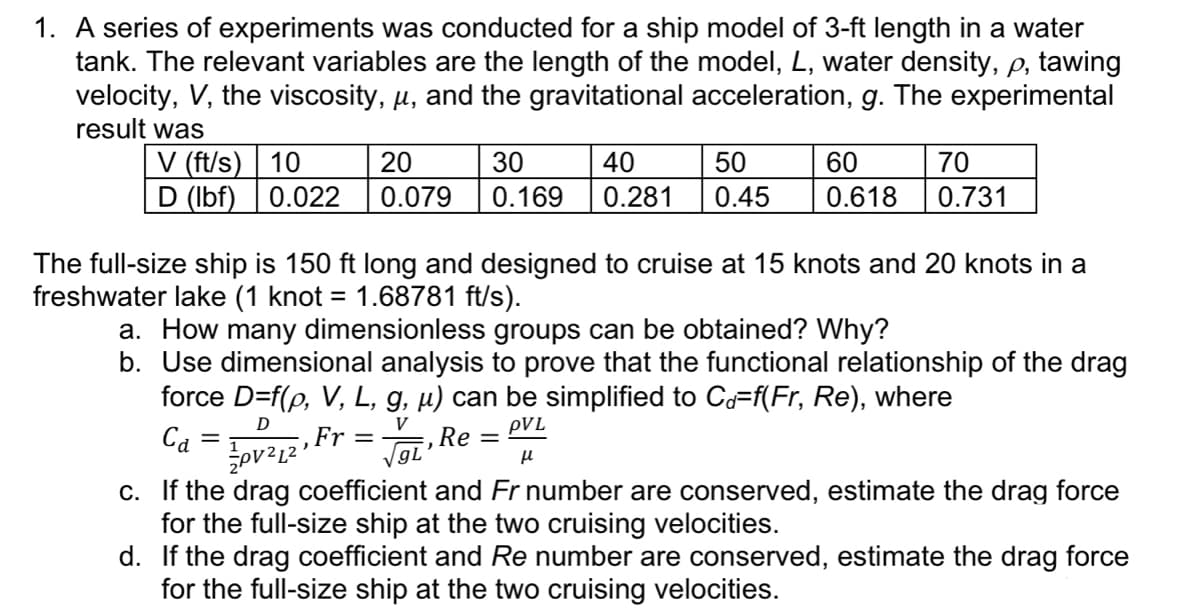A series of experiments was conducted for a ship model of 3-ft length in a water tank. The relevant variables are the length of the model, L, water density, p, tawing velocity, V, the viscosity, μ, and the gravitational acceleration, g. The experimental result was
A series of experiments was conducted for a ship model of 3-ft length in a water tank. The relevant variables are the length of the model, L, water density, p, tawing velocity, V, the viscosity, μ, and the gravitational acceleration, g. The experimental result was
Principles of Heat Transfer (Activate Learning with these NEW titles from Engineering!)
8th Edition
ISBN:9781305387102
Author:Kreith, Frank; Manglik, Raj M.
Publisher:Kreith, Frank; Manglik, Raj M.
Chapter5: Analysis Of Convection Heat Transfer
Section: Chapter Questions
Problem 5.8P
Related questions
Question
Please solve for all with a clear explanation ( fluid mechanics )

Transcribed Image Text:1. A series of experiments was conducted for a ship model of 3-ft length in a water
tank. The relevant variables are the length of the model, L, water density, p, tawing
velocity, V, the viscosity, µ, and the gravitational acceleration, g. The experimental
result was
V (ft/s) 10
20
D (lbf) 0.022 0.079
50
30 40
0.169 0.281 0.45
=
60
0.618
70
0.731
The full-size ship is 150 ft long and designed to cruise at 15 knots and 20 knots in a
freshwater lake (1 knot = 1.68781 ft/s).
a. How many dimensionless groups can be obtained? Why?
b. Use dimensional analysis to prove that the functional relationship of the drag
force D=f(p, V, L, g, µ) can be simplified to Cd=f(Fr, Re), where
D
V
Ca
-, Fr=
PVL
Re=
√gL
μl
PV²12
c.
If the drag coefficient and Fr number are conserved, estimate the drag force
for the full-size ship at the two cruising velocities.
d. If the drag coefficient and Re number are conserved, estimate the drag force
for the full-size ship at the two cruising velocities.
Expert Solution
This question has been solved!
Explore an expertly crafted, step-by-step solution for a thorough understanding of key concepts.
Step by step
Solved in 8 steps with 13 images

Follow-up Questions
Read through expert solutions to related follow-up questions below.
Follow-up Question
can you please do the quadratic interpolaton on paper so I can see how you did it
Solution
Follow-up Question
Can you please show how you got the quadratic interpolation please
Solution
Knowledge Booster
Learn more about
Need a deep-dive on the concept behind this application? Look no further. Learn more about this topic, mechanical-engineering and related others by exploring similar questions and additional content below.Recommended textbooks for you

Principles of Heat Transfer (Activate Learning wi…
Mechanical Engineering
ISBN:
9781305387102
Author:
Kreith, Frank; Manglik, Raj M.
Publisher:
Cengage Learning

Principles of Heat Transfer (Activate Learning wi…
Mechanical Engineering
ISBN:
9781305387102
Author:
Kreith, Frank; Manglik, Raj M.
Publisher:
Cengage Learning